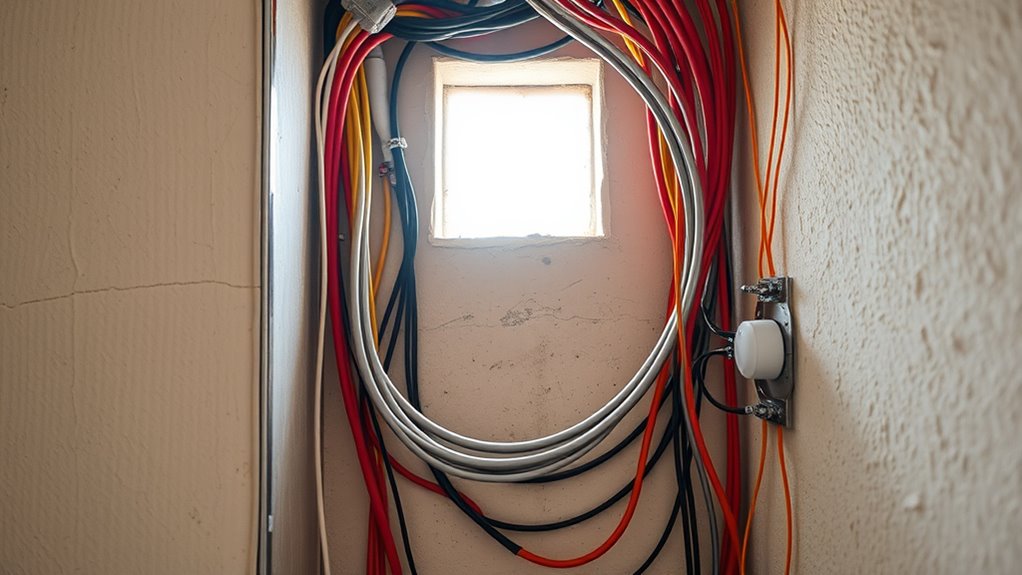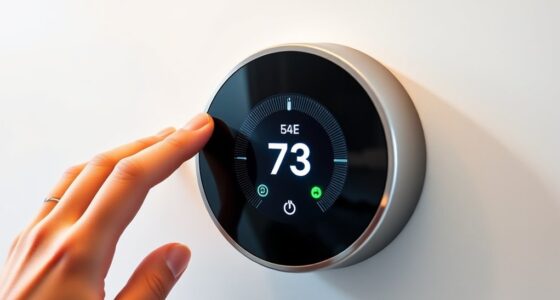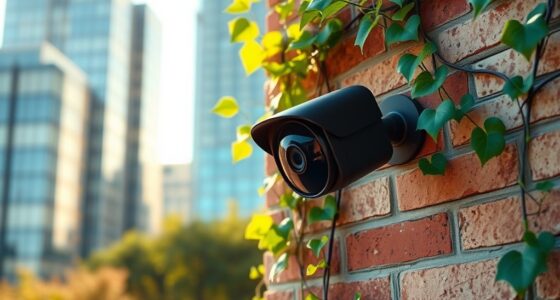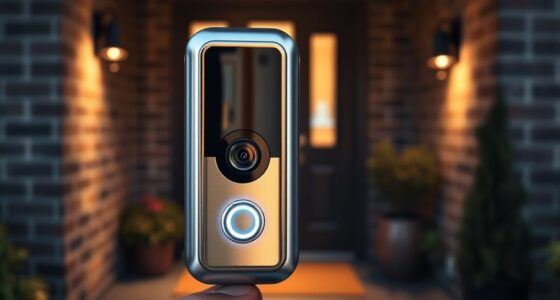Inside your walls, home wiring has evolved from simple, early systems to advanced, standardized practices that prioritize safety, durability, and efficiency. Gone are the days of knob-and-tube wiring; now, modern systems use color-coded cables, high-quality materials, and smart safety features like circuit breakers and fire-resistant insulation. Understanding these changes helps you appreciate how wiring keeps your home safe and ready for future technology. Keep exploring to discover how ongoing innovations impact your electrical system.
Key Takeaways
- Home wiring evolved from simple, industrial systems to standardized, safe, and reliable electrical networks using modern color codes and materials.
- Transition from knob-and-tube to circuit breakers improved safety, capacity, and ease of maintenance in residential wiring.
- Advances in insulation and materials enhance safety, energy efficiency, and resistance to environmental factors inside wall systems.
- Modern wiring practices support smart home technologies, higher power demands, and future upgrades, ensuring seamless connectivity and safety.
- Upgrading wiring systems reduces fire hazards, improves energy efficiency, and increases property value by ensuring safety and compliance with current standards.
The Origins of Home Wiring: Early Electrical Systems

Although home wiring has become an essential part of modern living, its origins trace back to the earliest electrical systems designed for industrial and public use. Early electrical systems used basic wiring methods, often relying on simple wiring gauges that could handle limited current loads. As electrical use expanded, circuit breakers were introduced to prevent overloads and protect wiring from damage. Initially, wiring gauges were chosen based on the current capacity needed, with thicker gauges used for higher loads. These early systems lacked standardization, leading to inconsistent safety and performance. Over time, improvements in circuit breaker technology and standardized wiring gauges helped make home wiring safer and more reliable, laying the foundation for today’s complex electrical systems. Additionally, advancements in home wiring standards have contributed to increased safety and efficiency in modern electrical installations.
The Rise of Standardized Wiring Practices
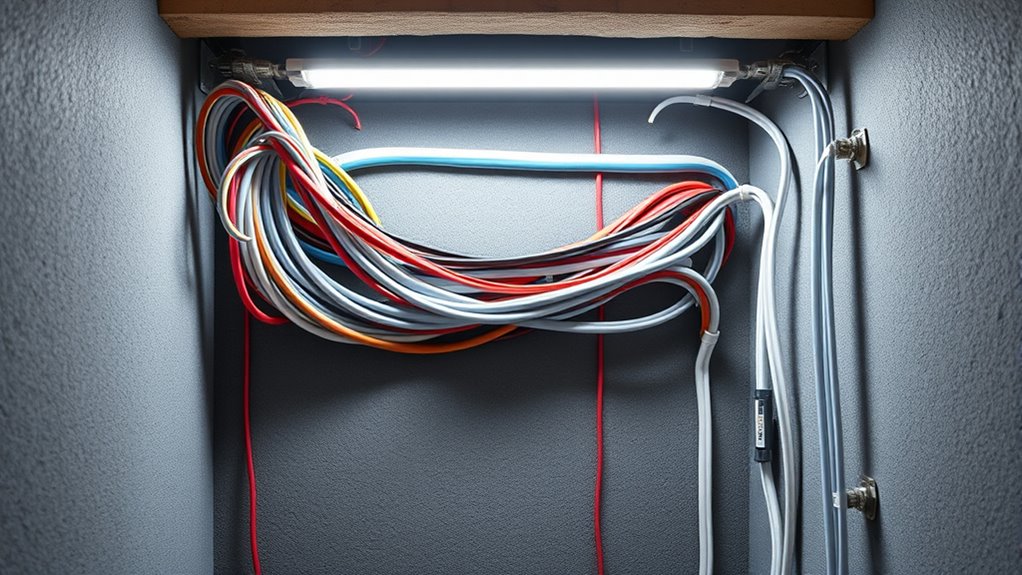
You’ll notice that wiring standards have brought greater consistency to installations, making it easier for professionals to follow reliable practices. These standards also prioritize safety, reducing the risk of electrical hazards in your home. As a result, you can feel more confident that your wiring system is both efficient and secure.
Consistency in Installation
As wiring systems have become more complex, the importance of consistency in installation has grown. You need to guarantee wire consistency and wiring uniformity to maintain safety and functionality. When electricians follow standardized practices, it reduces the risk of errors and makes troubleshooting easier later. Consistent wiring practices mean using the same color codes, cable types, and connection techniques throughout your home. This uniformity helps prevent confusion and ensures that each circuit functions correctly. By adhering to these standards, installers create reliable wiring systems that meet safety regulations and perform efficiently over time. Overall, the rise of standardized wiring practices highlights the value of consistency, making home wiring safer, more durable, and easier to maintain. Additionally, incorporating AI training jobs into the development and maintenance of wiring systems can enhance inspection accuracy and predictive maintenance, further improving safety and reliability.
Enhanced Safety Measures
Standardized wiring practices considerably enhance safety by reducing the risk of electrical hazards in your home. They ensure consistent installation methods, which improve circuit protection and fire safety. By adhering to these standards, you benefit from:
- Reliable circuit protection devices that prevent overloads and short circuits.
- Proper grounding techniques that minimize the risk of electric shocks.
- Uniform wiring color codes that help identify circuits quickly, reducing errors during maintenance or emergencies.
- Following electric power generation standards can also improve the efficiency and safety of your home’s electrical system.
These measures help prevent electrical fires and guarantee that your wiring meets safety codes. Standardization also streamlines troubleshooting, allowing quicker identification of problems. Overall, adopting these practices safeguards your home and loved ones, making electrical systems safer and more dependable.
Innovations in Insulation and Safety Features
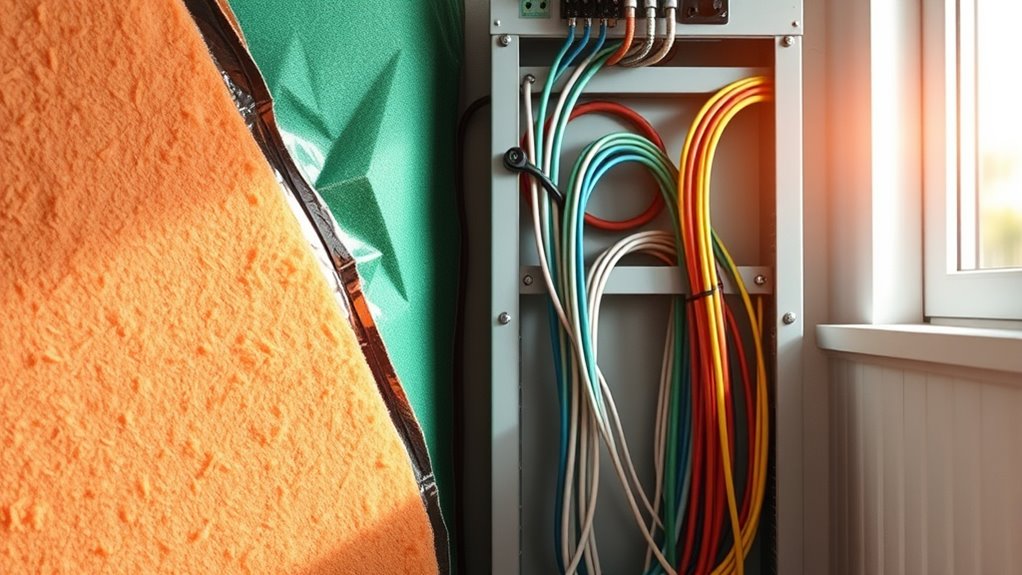
Innovations in insulation and safety features are making your home wiring safer and more efficient. Advanced materials, like flame-resistant and insulating compounds, protect your wiring from heat and damage. Smart safety devices and fire-resistant technologies further reduce risks, giving you peace of mind. Additionally, integrating modern wiring standards ensures your system remains resilient against potential hazards.
Advanced Insulation Materials
Recent advances in insulation materials have considerably enhanced both the safety and efficiency of home wiring systems. Modern insulation now includes innovative materials that serve as thermal barriers, reducing heat transfer and improving energy efficiency. These materials also offer superior moisture control, preventing mold growth and electrical hazards caused by dampness. You’ll find three key improvements: 1. Enhanced thermal barriers that protect wiring from temperature fluctuations. 2. Moisture-resistant layers that prevent water intrusion and corrosion. 3. Eco-friendly options that improve insulation performance without harming the environment. Additionally, these innovative materials contribute to beach-inspired designs in sustainable construction, emphasizing durability and environmental friendliness.
Smart Safety Devices
As home wiring systems become more sophisticated with advanced insulation materials, integrating smart safety devices further enhances their reliability. Wireless sensors are now commonly embedded throughout walls, monitoring for issues like overheating, moisture, or electrical faults in real time. These sensors communicate wirelessly with smart safety devices, enabling instant alerts if a problem arises. For example, smart circuit breakers can automatically shut off power during a fault, preventing damage and reducing fire risk. This integration means you can receive notifications on your phone, allowing you to respond quickly, even when away. Additionally, smart wiring systems are designed to adapt to future technological advancements, ensuring your home remains safe and up-to-date. Overall, these innovations make your home safer by providing continuous monitoring and immediate action, reducing hazards and giving you peace of mind.
Fire-Resistant Technologies
Fire-resistant technologies have become a essential part of modern home wiring, substantially enhancing safety through advanced insulation materials and safety features. You’ll find innovations such as fire resistant coatings applied to wiring and flame retardant wiring designed to slow or prevent the spread of flames. These technologies improve safety by reducing fire risks and limiting damage. Specifically, you should know:
- Fire resistant coatings are applied to cables, providing a protective barrier against heat and flames.
- Flame retardant wiring incorporates materials that resist ignition and inhibit flame propagation.
- Modern wiring systems often include safety features like automatic shut-offs triggered by heat or smoke detection, further minimizing fire hazards.
- AI security technologies are increasingly integrated into fire safety systems to enhance threat detection and response.
These advancements ensure your home’s wiring is safer, resilient, and compliant with modern fire safety standards.
The Transition From Knob-And-Tube to Modern Wiring
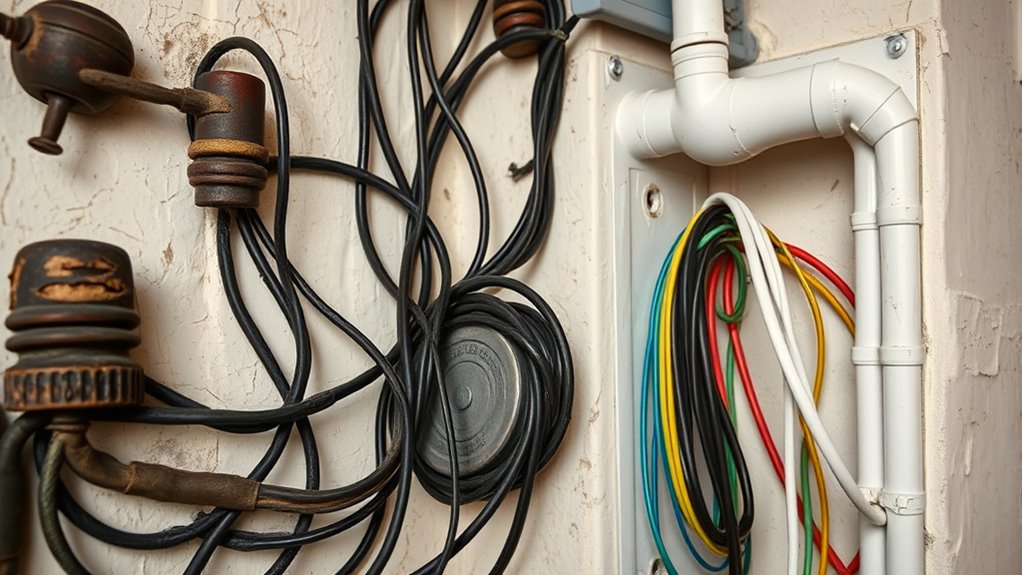
The shift from knob-and-tube wiring to modern electrical systems marked a significant milestone in home safety and functionality. During this progression, homes adopted circuit breaker upgrades, replacing fuse boxes for safer, more reliable power control. Modern wiring also introduced standardized wiring color codes, making it easier for electricians to identify circuits and troubleshoot issues. You’ll notice black or red wires for hot lines, white for neutral, and green or bare copper for ground, which enhances safety and simplifies repairs. This evolution improved electrical capacity, reduced fire risks, and allowed for more extensive electrical systems to support new appliances and technology. Overall, moving away from knob-and-tube wiring was essential for adapting homes to modern demands and ensuring safer, more efficient electrical systems. Additionally, the integration of wall organization systems has made home wiring more accessible for maintenance and upgrades.
The Impact of Technological Advancements on Wiring Design
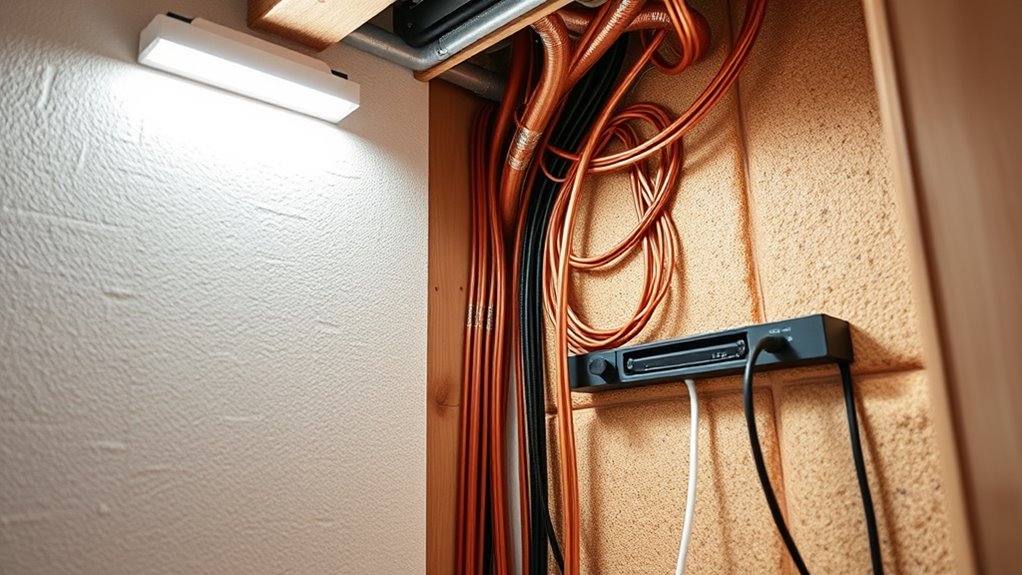
Technological advancements have transformed wiring design to support smart home features and higher power needs. You now need wiring that can handle wireless devices and increased energy demands safely. These changes shape how modern homes are wired to keep up with innovation. Additionally, modern wiring solutions often incorporate vertical storage solutions to optimize space and ensure safe, organized electrical systems.
Smart Home Integration
As smart home technology becomes increasingly integrated into daily life, wiring designs must adapt to support these advanced systems. You’ll need to plan for more sophisticated wiring conduits that accommodate multiple data and power lines. This includes:
- Installing dedicated circuits, connected to a reliable circuit breaker, to handle increased load from smart devices.
- Using flexible wiring conduit to organize and protect the complex network of sensors, cameras, and automation hubs.
- Incorporating additional outlets and data ports, ensuring seamless connectivity throughout your home.
- Designing your wiring system with future expansion in mind, so it can easily support new smart technologies as they emerge.
These updates ensure your wiring system can support future upgrades without costly modifications. Proper planning now helps prevent overloads, wiring damage, and connectivity issues down the line, making your home truly smart and efficient.
Increased Power Demands
Have you noticed how modern devices demand more power than ever before? This increase impacts your home’s wiring, requiring higher circuit capacity to handle the load safely. As devices like smart appliances, home theaters, and electric vehicles become common, your wiring must support greater power distribution without overloads. Older wiring systems often weren’t designed for these demands, leading to potential hazards or frequent tripped circuits. Upgrading your electrical system ensures your home can supply reliable power while maintaining safety standards. Proper circuit capacity planning allows for future expansion and prevents electrical failures. This evolution in wiring design reflects the need to adapt to our tech-heavy lifestyles, ensuring your home remains functional, safe, and capable of supporting current and future power demands.
Wireless Technology Adoption
Wireless technology has revolutionized how we connect and interact at home, reducing the reliance on physical wiring for data transmission. As a result, wiring designs now prioritize flexibility and minimal wiring complexity. With increased adoption of wireless technology, your home can seamlessly support smart device integration, enabling automation and remote control. Consider these key impacts:
- Simplified wiring plans that focus on power rather than data cables.
- Increased reliance on Wi-Fi networks to handle high data demands.
- Enhanced compatibility for smart devices, reducing the need for dedicated wiring.
This shift allows for more adaptable layouts and easier upgrades. You can enjoy a smarter home without extensive rewiring, making your living space more efficient and future-proof.
Smart Home Integration and Networked Wiring Solutions
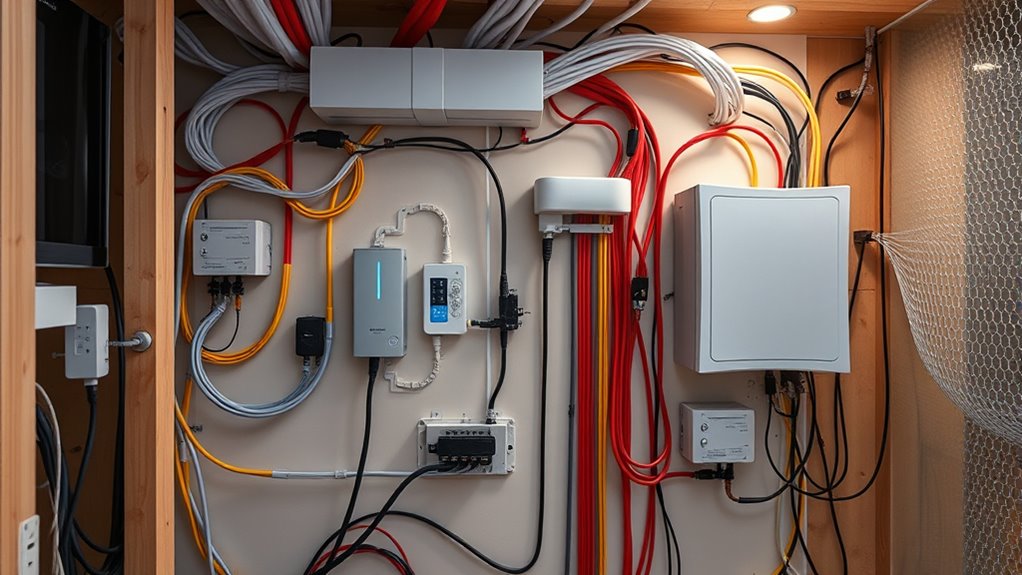
How can your home keep up with the latest technology? Smart home integration offers seamless control over devices through networked wiring solutions. You can connect lighting, thermostats, security systems, and appliances for centralized management. Wireless communication plays a essential role, enabling devices to communicate efficiently without cluttering your walls with cables. This setup enhances energy management by optimizing usage, reducing waste, and lowering bills. Modern wiring systems are designed to support these connected devices, ensuring reliable data flow and quick responses. With networked wiring, you gain the flexibility to expand your smart home ecosystem easily. Staying updated with these advancements means your home becomes more convenient, energy-efficient, and ready for future innovations.
Materials and Techniques: Improving Durability and Efficiency
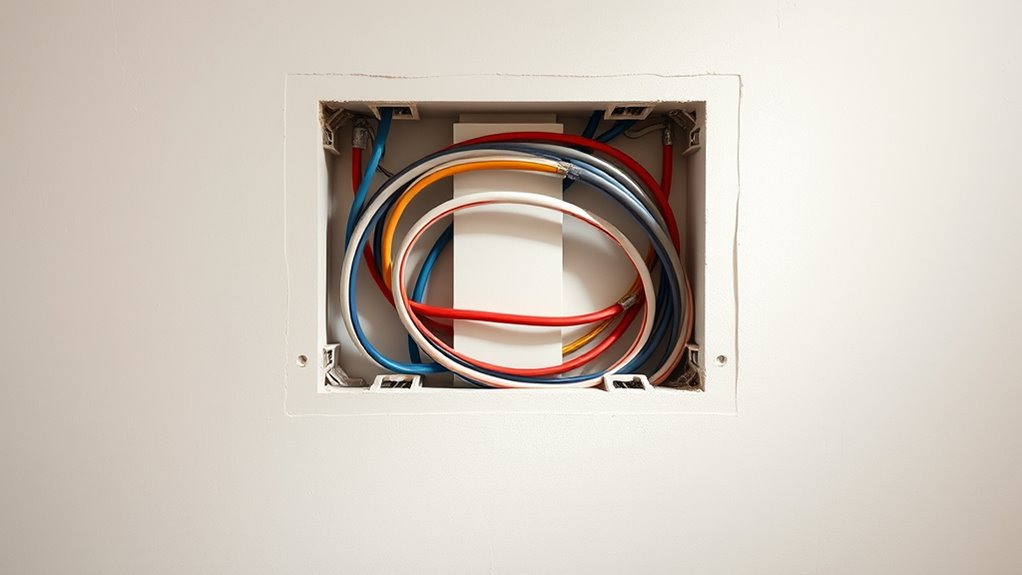
Choosing the right materials and techniques is essential for enhancing the durability and efficiency of your home wiring. Modern wiring employs high-quality copper conductors, which provide excellent conductivity and longevity. To maximize safety and performance, you should focus on:
- Selecting durable insulation materials that resist heat, moisture, and wear.
- Using advanced techniques like proper grounding and secure connections to prevent faults.
- Implementing organized wiring layouts to reduce strain on conductors and facilitate future upgrades.
Building Codes and Regulations: Evolving Safety Standards
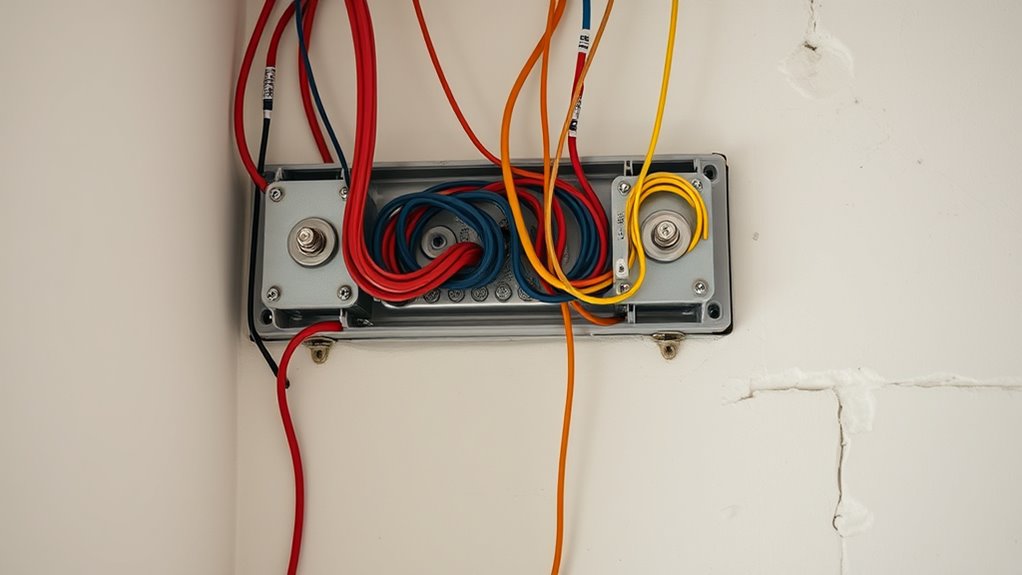
Building codes and regulations play a crucial role in ensuring your home wiring meets safety standards and prevents hazards. These electrical codes set strict guidelines for circuit safety, making sure wiring is installed correctly and safely. As wiring systems have evolved, regulations have adapted to incorporate new materials, techniques, and safety features. Modern electrical codes require proper grounding, circuit breakers, and GFCIs to protect against electrical shocks and fires. They also specify wire gauges and insulation standards to handle increased power demands. Staying compliant with these evolving standards guarantees that your wiring is safe, reliable, and capable of preventing electrical accidents. Adhering to updated electrical codes is essential for protecting your home and loved ones from potential hazards caused by outdated or improperly installed wiring.
Future Trends in Home Wiring and Connectivity
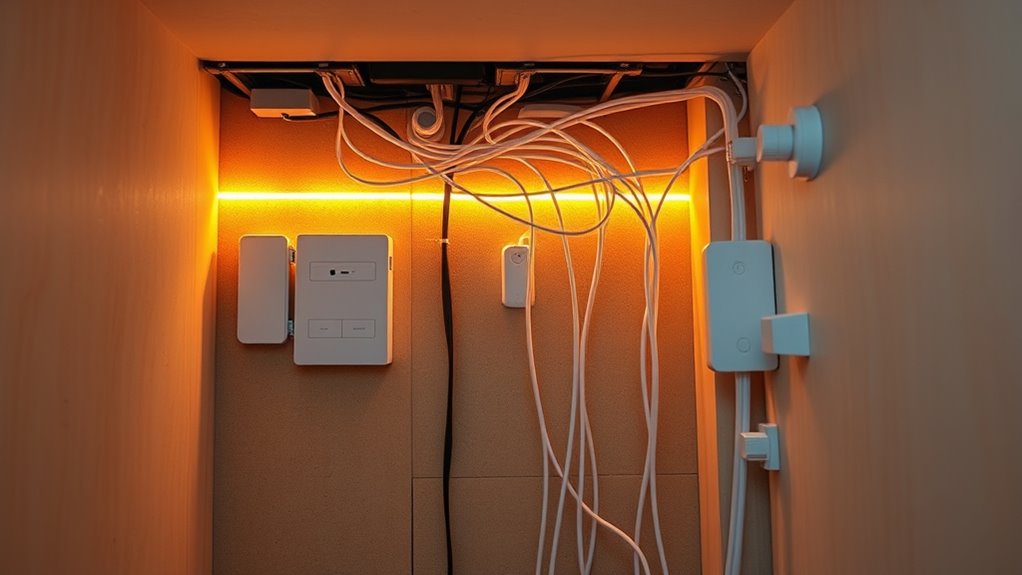
As home wiring standards continue to evolve, new technologies are shaping the way you connect and power your living spaces. Future trends focus on seamless wireless connectivity, reducing reliance on traditional wiring for smart devices. You can expect:
- More widespread use of wireless systems that eliminate bulky cables, making setups cleaner and more flexible.
- The adoption of energy-efficient wiring solutions, which minimize power waste and support eco-friendly homes.
- Integration of smart wiring networks that adapt to your needs, providing faster, more reliable connections for everything from entertainment to security.
These advancements not only enhance convenience but also promote sustainability. Staying ahead means embracing these innovations to create a smarter, more efficient home environment.
How Understanding Wiring Evolution Benefits Homeowners
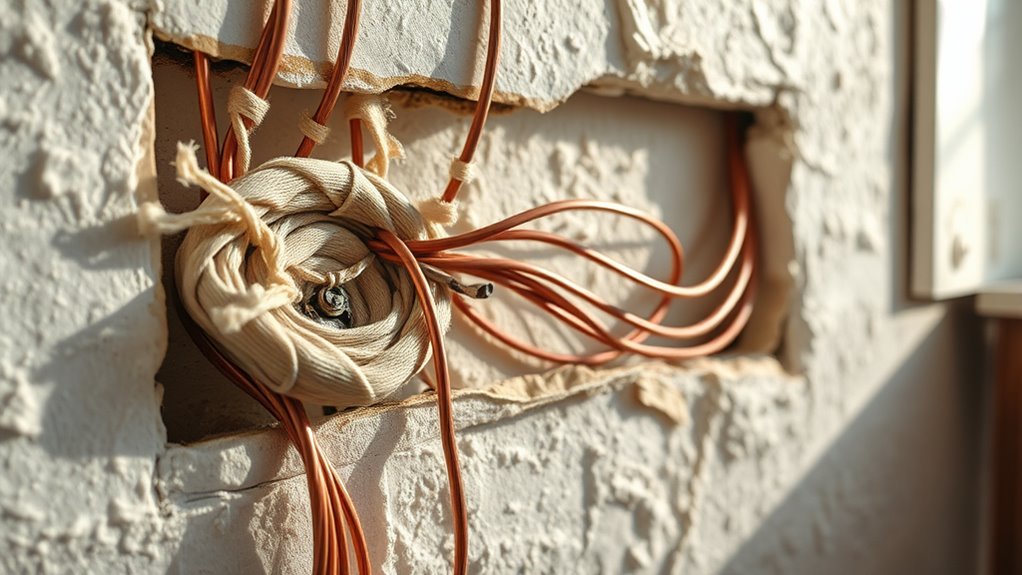
Understanding the evolution of home wiring helps you make informed decisions that enhance safety, efficiency, and convenience. By recognizing how wiring standards have changed, you can identify when upgrades like modern circuit breaker panels are necessary to prevent overloads and electrical fires. Upgrading circuit breakers not only boosts safety but also improves energy efficiency by reducing wasted power. Knowing the history of wiring allows you to assess whether your home’s electrical system can handle modern appliances and technology demands. It also helps you plan for future upgrades, saving you money and hassle. Staying aware of wiring evolution empowers you to prioritize safety, optimize energy consumption, and increase your home’s value, ensuring your electrical system keeps pace with your lifestyle.
Frequently Asked Questions
How Can I Tell if My Home Wiring Is Outdated or Unsafe?
You can tell if your wiring is outdated or unsafe by checking for signs like frequent circuit overloads or unexplained tripped breakers. Look for exposed wires, burn marks, or discolored outlets, which may indicate ground faults or overheating. If your home has knob-and-tube wiring or aluminum wiring, it’s likely outdated. It’s wise to have a professional inspect your system regularly to guarantee safety and prevent electrical hazards.
What Are the Signs of Wiring Problems Linked to Technological Upgrades?
Your home’s wiring may be throwing a digital temper tantrum if you notice flickering lights or devices that refuse to connect. These signs often point to wiring problems tied to outdated infrastructure struggling with wireless integration and smart device compatibility. As your tech grows smarter, your wiring should keep pace. If it doesn’t, you risk connectivity issues or electrical hazards, so consider a wiring upgrade to keep your home running smoothly in the digital age.
Are There Specific Materials Best Suited for Modern Wiring Installations?
When choosing materials for modern wiring installations, you should focus on wireless wiring options for easier setup and eco-friendly materials that reduce environmental impact. Look for fire-resistant, low-toxic cables made from sustainable resources. These materials guarantee safety, support green living, and keep your home up-to-date with current standards. Prioritizing eco-friendly wiring and incorporating wireless solutions helps you create a safer, more efficient, and environmentally conscious home.
How Do Building Codes Differ Across Regions for Electrical Safety?
You might think building codes are the same everywhere, but regional standards and safety regulations vary substantially. These differences are based on local climate, fire risk, and electrical infrastructure. It’s vital to follow your area’s specific codes to guarantee safety and compliance. Ignoring regional standards can lead to hazards or legal issues, so always consult local authorities or a professional electrician to understand the requirements for your home.
What Future Innovations Could Further Change Residential Wiring Systems?
You’ll see future residential wiring innovate with smart grid integration, allowing your home to communicate seamlessly with energy providers for optimized usage. Wireless power transfer might eliminate complex wiring altogether, offering more flexible and cleaner setups. These advancements will make your home safer, more efficient, and easier to upgrade, transforming how you power your everyday life and reducing reliance on traditional wiring systems.
Conclusion
Understanding your wall wiring’s evolution empowers you to make smarter, safer decisions. By knowing how wiring has advanced from primitive to modern, you can better appreciate safety standards, spot potential issues, and stay prepared for future innovations. Stay savvy about your space’s wiring, and you’ll secure your sanctuary’s safety, stability, and style. Remember, knowledge of wiring’s winding journey keeps your home wired for wellness and worry-free living.
